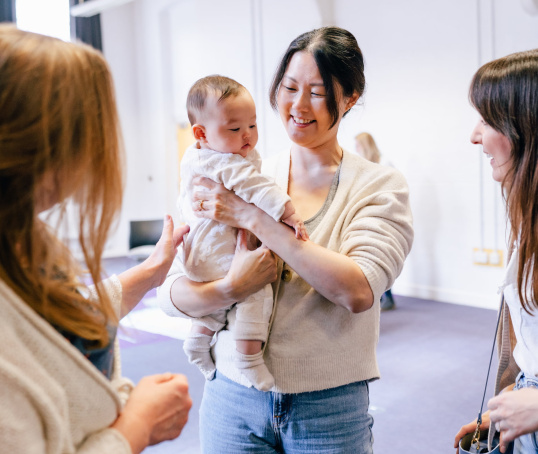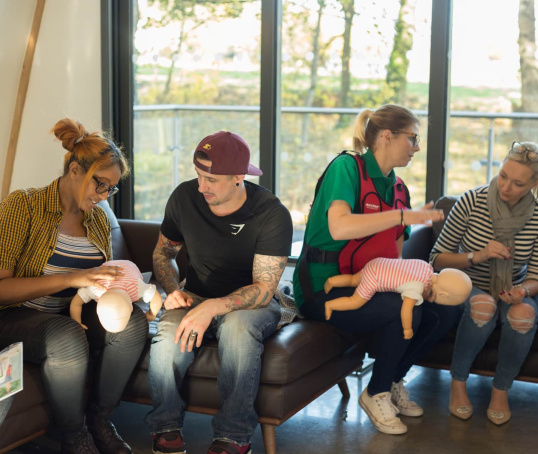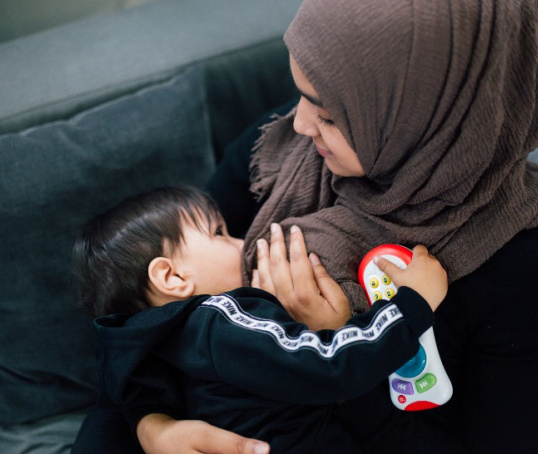They’re past the newborn stage but still figuring out how to get a good night’s sleep. Here are some ways you can guide them in the right direction.
Try to have a regular bedtime and routine
Some parents choose to begin a bedtime routine during the evening, perhaps at a time when their baby seems sleepy.
A regular series of events, for example a bath, story then milk in a dark room, can help a baby to calm down ready for sleep and sleep longer at night (Mindell et al, 2006; St James-Roberts, 2012; Staples et al, 2015). Once your baby recognises the routine, you could bring their bedtime forward to a time that suits you.
Watch our video for tips on getting your baby to sleep.
Make day versus night clear
When your baby wakes up in the middle of the night, try to keep the lights dim. Plus, keep talking and playing to a minimum.
Babies vary a lot in how long it takes them to develop regular waking and sleeping times (Paavonen et al, 2020). But if you’re worried about your older baby's sleep, you could have a chat with your health visitor about it.
What are dream feeds?
Frequent feeds are part of your baby’s normal development (Horne et al, 2004). Some parents find it helpful to offer extra feeds during the evening. Or parents might semi-wake their baby for a feed between 10pm and midnight, which is sometimes called dream feeding.
Dream feeds are based on the idea of scheduled awakening. This means waking the baby a little before they would wake themselves, and soothing them to sleep in the normal way (which might include rocking or feeding). Over time, this can help the gaps between awakenings to increase (Mindell et al, 2006). Both these techniques are used by parents who are breastfeeding and/or formula feeding.
Do these techniques help a baby to sleep longer? While some parents say it worked for them the evidence doesn't conclusively suggest it does (Dewar, 2018).
Get some daylight
Babies’ sleep can be affected by daylight and their body temperature. Time spent in daylight, especially in the afternoons, seems to help babies to sleep for longer at night (Thomas et al, 2016).
Some parents hope keeping their baby awake during the day will help them sleep at night. But like other sleep training, this ignores normal infant sleep development and risks not observing the cues your baby is giving about their needs (BASIS, no date). Some parents also feel that their baby becomes ‘over-tired’, which can be really stressful in itself.
Know when your baby is tired
These are some of the signs that might show your baby is tired and ready for a sleep:
• yawning
• jerky movements
• becoming quiet or not wanting to play
• becoming fussy
• rubbing their eyes
• crying
• clenched fists.
Keep baby close
It’s perfectly fine to keep your baby in the same room as you while you watch TV or relax in the evening. They can lie on you or in a Moses basket.
Contact napping, where your baby falls asleep on you, is normal and fine when there is someone else with you who can make sure you don’t fall asleep too (Ockwell-Smith, 2016). Then when you go to bed, take them with you. This means you can respond quickly when they stir, and also means that you don’t need to worry about them.
Putting your baby down to bed
Some parents find it helps to place their baby sleepy, but awake, in their cot or Moses basket. But there is no evidence to back this up.
Remember, babies should be sleeping in the same room as an adult until six months, to reduce the risk of SIDS (Ramirez et al, 2018; Lullaby Trust, 2021).
Swaddling a baby
Swaddling might help babies settle to sleep but there have been some safety concerns (Richardson et al, 2009). See The Lullaby Trust for safety advice on swaddling and our guide on how to swaddle before you do it.
Sleep training methods
Some parents explore sleep training approaches to encourage a regular sleeping pattern. This is known as controlled crying or letting the baby 'cry it out'.
While many studies have shown that sleep training can change a baby's behaviour, they don't show whether this lasts. There has also been very little research that looks at the effects of sleep training on babies, beyond the effect on their sleep (or crying) (BASIS, no date).
All babies are different
Some babies need more help than others to fall asleep. But most babies will develop a regular sleep pattern over time, although these will continue to change as they grow.
All children will eventually develop the ability to fall asleep without a parent being present, though this is likely to happen when they're closer to a year old and not in the early months. For tips on how to cope with a lack of sleep, see here.
This page was last reviewed in November 2021
Further information
Our support line offers practical and emotional support with feeding your baby and general enquiries for parents, members and volunteers: 0300 330 0700.
The Lullaby Trust has lots of useful information and support for parents about safe sleep.
You might find attending one of our NCT New Baby courses helpful as they give you the opportunity to explore different approaches to important parenting issues with a qualified group leader and other new parents in your area.
Make friends with other parents-to-be and new parents in your local area for support and friendship by seeing what NCT activities are happening nearby.
BASIS (Baby Sleep Info Source). (no date) Normal sleep development. Available at: https://www.basisonline.org.uk/normal-sleep-development/ [Accessed 16th November 2021]
Dewar G. (2018) Dream feeding: an evidence based guide to helping babies sleep longer. Available at: https://www.parentingscience.com/dream-feeding.html [Accessed 16th November 2021]
Horne RSC, Parslow PM, Ferens D, Watts AM, Adamson TM. (2004) Comparison of evoked arousability in breast and formula fed infants. Archives of disease in childhood. 89:22-25. Available at: https://www.ncbi.nlm.nih.gov/pubmed/14709496 [Accessed 16th November 2021]
Lullaby Trust. (2021) How to reduce the risk of SIDS. Available at: https://www.lullabytrust.org.uk/safer-sleep-advice/ [Accessed 16th November 2021]
Mindell J, Kuhn B, Lewin DS, Meltzer LJ, Sadeh A. (2006) Behavioral treatment of bedtime problems and night wakings in infants and young children. Sleep. 29(10):1263-1276. Available at: https://doi.org/10.1093/sleep/29.10.1263 [Accessed 16th November 2021]
Ockwell-Smith S. (2016) When your child will only nap on you. Available at: https://sarahockwell-smith.com/2016/12/14/when-your-child-will-only-nap… [Accessed 16th November 2021]
Paavonen EJ, Morales-Muñoz I, Pölkki P, Paunio T, Porkka-Heiskanen T, Kylliäinen A, et al (2020). Development of sleep-wake rhythms during the first year of age. J Sleep Res. 29(3):e12918. Available at: doi: 10.1111/jsr.12918. [Accessed 16th November 2021]
Ramirez JM, Ramirez SC, Anderson TM. (2018) Sudden infant death syndrome, sleep, and the physiology and pathophysiology of the respiratory network. In: SIDS Sudden Infant and Early Childhood Death: The Past, the Present and the Future. Adelaide (AU): University of Adelaide Press; 2018 May. Chapter 27. Available at: https://www.ncbi.nlm.nih.gov/books/NBK513387/ [Accessed 16th November 2021]
Richardson HL, Walker AM, Horne RS. (2009) Minimizing the risks of sudden infant death syndrome: to swaddle or not to swaddle? J Pediatrics. 155(4):475-481. Available at: https://doi.org/10.1016/j.jpeds.2009.03.043 [Accessed 16th November 2021]
St James-Roberts I. (2012). The origins, prevention and treatment of infant crying and sleeping problems. London: Routledge.
Staples AD, Bates JE, Petersen IT. (2015) Bedtime routines in early childhood: prevalence, consistency, and associations with nighttime sleep. Monographs Society Res Child, 80:141-159. Available at: https://www.ncbi.nlm.nih.gov/pubmed/25704740 [Accessed 16th November 2021]
Thomas KA, Burr RL, Spieker S. (2016) Light and maternal influence in the entrainment of activity circadian rhythm in infants 4-12 weeks of age. Sleep Biol Rhythyms. 14(3):249-255. Available at: https://www.ncbi.nlm.nih.gov/pmc/articles/PMC4955618/ [Accessed 16th November 2021]







